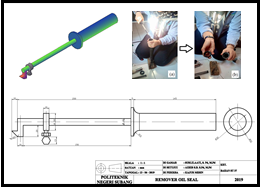Main Article Content
Abstract
Although simple, removing the front fork telescopic (TFF) seal on a motorcycle without special service tools (SST) can cause work accidents for mechanics and loss for consumers and workshops. Therefore, product development research has been carried out to design a seal remover for TFF. Then, a TRL measurement using Techno-meter was done on the prototype that has been developed. A quick measurement by Techno-meter shows that the prototype has reached level 6 (intermediate), where the prototype has been demonstrated/tested in a relevant environment. In conclusion, through continued work (reviewing products, improvising, and testing prototypes on a larger scale), this prototype promises to be mass-produced as downstream of research products to the market.
Keywords
Article Details
References
- S. Das, J. Lal, A. Dey, G. Mukhopadhyay, and S. Bhattacharya, “Surface Defect in Telescopic Front Fork: A Metallurgical Analysis,” Journal of Steel Structures & Construction, vol. 4, no. 2, pp. 4–9, 2018.
- M. M. Rahman, K. Kadirgama, M. M. Noor, and M. R. M. Rejab, “Fatigue life prediction of lower suspension arm using strain-life approach,” European Journal of Scientific Research, vol. 30, no. 3, pp. 437–450, 2009.
- C. Q. Howard, N. Sergiienko, and G. Gallasch, “Monitoring the age of vehicle shock absorbers,” in International Conference on Science and Innovation for Land Power 2018, 2018.
- Fahrudin, “Alat Bantu Pelepas Stopper Ring Pada Suspensi Depan Tipe Teleskopik Honda C100 Series,” Universitas Negeri Yogyakarta, 2013.
- K. Yu, L. Zhou, C. Hu, L. Wang, and W. Jin, “Analysis of Influencing Factors of Occupational Safety and Health in Coal Chemical Enterprises Based on the Analytic Network Process and System Dynamics,” Processes, vol. 7, no. 1, p. 53, 2019.
- A. Efendi and D. Komarudin, “Evaluation of the Application of Occupational Safety and Health (OSH) at the Subang State Polytechnic Laboratory,” Automotive Experiences, vol. 2, no. 1, pp. 9–14, 2019.
- H. Sofyan and A. Efendi, “Implementation of Teacherpreneurship on Teachers at Vocational High School,” in Proceedings of the International Conference on Technology and Vocational Teachers (ICTVT 2017), 2017, vol. 102, pp. 229–236.
- D. Nurhadi and N. Lyau, “Cultivating Responsibilities of Vocational Teachers: A Framework for Preparing Education to Work,” Jurnal Pendidikan Teknologi dan Kejuruan, vol. 24, no. 2, pp. 295–302, 2018.
- M. Shahbaz, Srinivas, J. A. Harding, and M. Turner, “Product design and manufacturing process improvement using association rules,” Proceedings of the Institution of Mechanical Engineers, Part B: Journal of Engineering Manufacture, vol. 220, no. 2, pp. 243–254, 2006.
- K. Muto, K. Kimita, and Y. Shimomura, “A guideline for product-service-systems design process,” Procedia CIRP, vol. 30, pp. 60–65, 2015.
- N. Bhuiyan, “A framework for successful new product development,” Journal of Industrial Engineering and Management, vol. 4, no. 4, pp. 746–770, 2011.
- D. W. Engel, A. . Dalton, K. Anderson, C. Sivaramakrishnan, and C. Lansing, “Development of Technology Readiness Level (TRL) Metrics and Risk Measures,” Brussels, 2017.
- M. Héder, “From NASA to EU: The evolution of the TRL scale in Public Sector Innovation,” Innovation Journal, vol. 22, no. 2, pp. 1–23, 2017.
- J. Straub, “In search of technology readiness level (TRL) 10,” Aerospace Science and Technology, vol. 46, pp. 312–320, 2015.
- Å. Fast-Berglund, L.-O. Bligård, M. Åkerman, and M. Karlsson, “Using the TRL-methodology to Design Supporting ICT-tools for Production Operators,” Procedia CIRP, vol. 17, pp. 726–731, 2014.
- T. Chinkatham, A. Souili, A. Taheri, and D. Cavallucci, “An Approach to Identify the Readiness Level of a Solution Concept in the Inventive Design Method,” Procedia CIRP, vol. 39, pp. 179–184, 2016.
- T. Altunok and T. Cakmak, “A technology readiness levels (TRLs) calculator software for systems engineering and technology management tool,” Advances in Engineering Software, vol. 41, no. 5, pp. 769–778, 2010.

